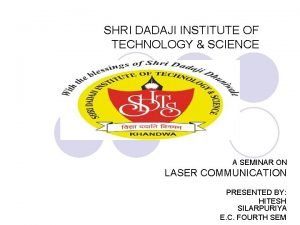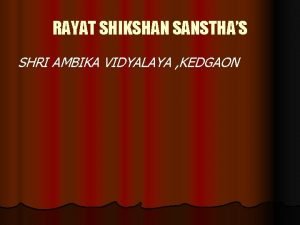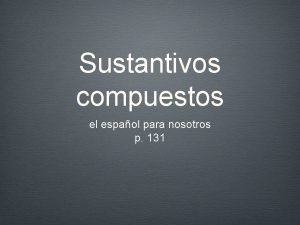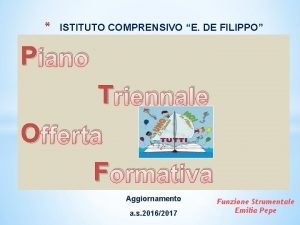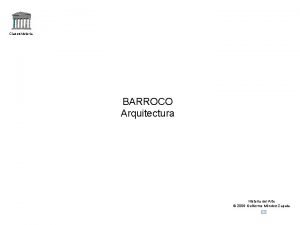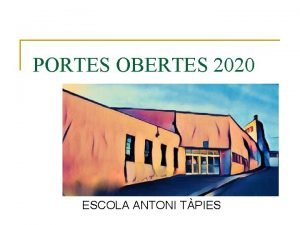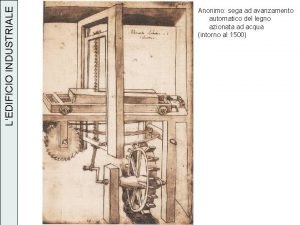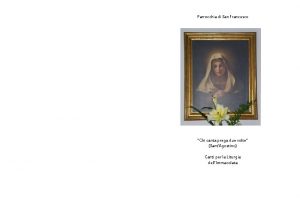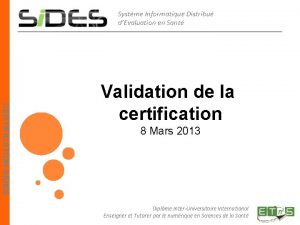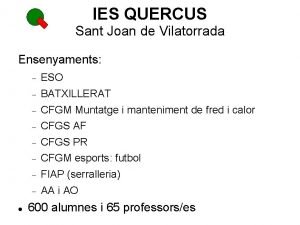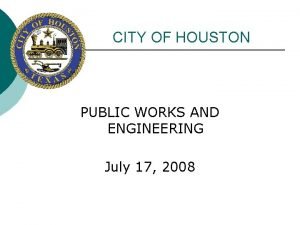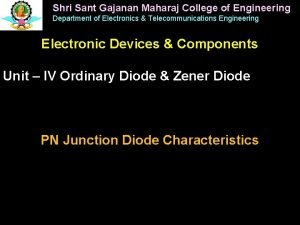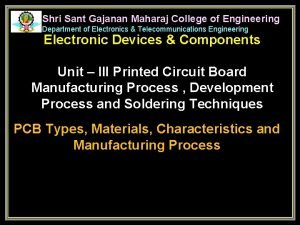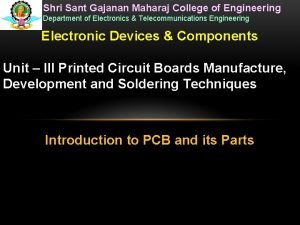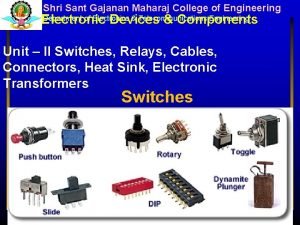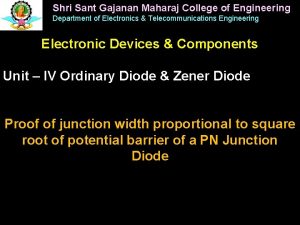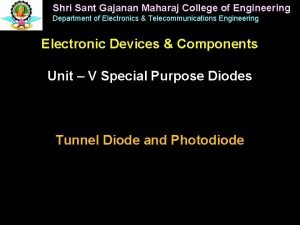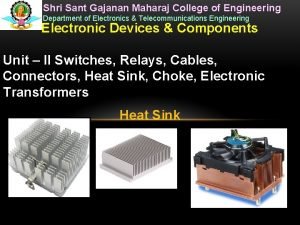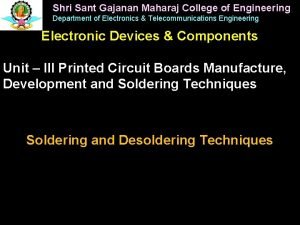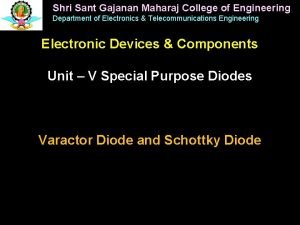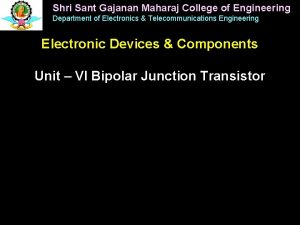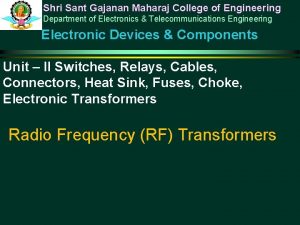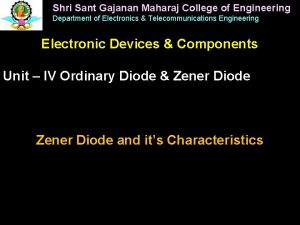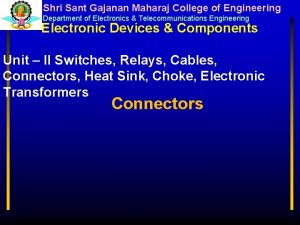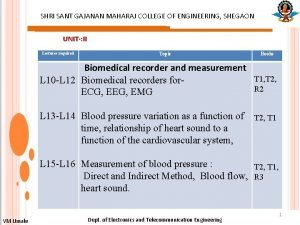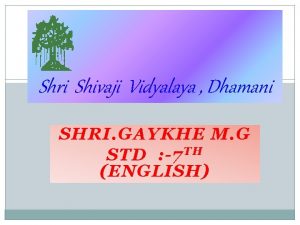Shri Sant Gajanan Maharaj College of Engineering Department


























































- Slides: 58

Shri Sant Gajanan Maharaj College of Engineering Department of Electronics & Telecommunications Engineering Electronic Devices & Components Unit – II Switches, Relays, Cables, Connectors, Heat Sink, Fuses, Choke, Electronic Transformers Choke

Choke is used in fluorescent tube light circuit

Choke It is iron core inductor

Choke It is also known as AC Inductor, Magnetic Ballast

Choke Aluminum case acts as a heat sink

Choke The magnetic core is made up of ferromagnetic material known as Silicon Steel [3% silicon, 97% Iron]

Choke It operates at 50 Hz in India and at 60 Hz in USA & European countries. Its function is to limit initial current in tubelight

Choke • It is iron cored inductor • Since inductor opposes changes in current it obstructs means ‘chokes’ the current. Hence the name ‘choke’ • Also known as AC Inductor • Also known as Magnetic Ballast

Tubelight The components of tubelight are; (1)Fluorescent Tube (2)Choke (3)Starter

Fluorescent Tube It is glass tube coated with phosphor on inner wall

Fluorescent Tube It also contains mercury that remains in molten state under normal condition

Fluorescent Tube It is filled with Argon gas. With application of voltage, gas discharges to produce a line of UV between electrodes

Fluorescent Tube The starter is capacitor with bi-metallic strip switch connected in parallel. When tubelight is turned on, bimetallic strips get shorted for a small duration

Fluorescent Tube Phosphor mixed with various chemical elements gives different colours

Fluorescent Tube Physical Dimensions The significant dimensions of fluorescent tube are: • Bulb diameter • Nominal overall length Tube Diameter: 1 ½ inches Overall Length : 18 inch

Fluorescent Tubelight Ballast Starter Light Clip

Fluorescent Tube Data Sheet

Tubelight Circuit

Tubelight Circuit Choke is connected in series with supply voltage. The starter is connected across the fluorescent tube. Cathode gets heated and emits electrons

Fluorescent Tube: What does it contain? • The fluorescent tube has mercury in liquid form • The fluorescent tube inner wall is coated with phosphor material • The fluorescent tube is filled with inert gas like Argon at low pressure

Fluorescent Tube: Why does it glow?

Fluorescent Tube: Why does it glow? • When voltage is applied across tube, cathode emits electrons, mercury turns in to gaseous form • Electrons interact with mercury atoms and photons are released. It is ultra violet UV radiation. • Argon gas gets discharged and invisible glow of UV light is formed between ends of the tube • The photons strike inner glass surface coated with phosphor and the glow becomes visible • Fluorescent lamps phosphors emit white light • Specialty lamps phosphors emit colored light • Blue, green, yellow, orange, red, violet, etc.

Fluorescent Tube: Why does it glow? • A mercury lamp emits mostly invisible UV light • To convert its UV light to visible light, inner wall of fluorescent tube is coated with phosphor • Phosphors absorb photons and reemit new photons • New photon energy is less than old photon energy • Fluorescent lamps phosphors emit white light • Specialty lamps phosphors emit colored light • Blue, green, yellow, orange, red, violet, etc.

Fluorescent Tube: Why does it glow? • When the tube is energized, the filaments at the end will glow producing heat and little light. • The heat vaporizes the mercury in the tube. • Once the mercury is vaporized, electrons flow in the mercury vapor. Ultraviolet light is produced. • The light strikes the phosphor coating and causes it to glow creating phosphorous light. (very little heat)

Fluorescent Tube: Why does it glow?

Fluorescent Tube: Why does it glow? • It has mercury, argon gas and wall is coated with phosphor • Inject free charges via temperature or high voltage • Forms a plasma—a gas of charged particles • Electric field produces current flow in plasma • Excited atoms interact with phosphor and emit visible light by principle of fluorescence

Fluorescent Tube: Why does it glow?

Inside the Choke Internal structure of the ballast is also coated with fiber glass reinforced polyester resin that covered the rear portion of the ballast. The connecting plugs are tightly attached to the ballast through this resin and cardboard paper. This is done to provide high level of insulation while having lower costs. The wires emerging out of the plugs are also insulated well before they connect to the copper windings. Core is made of Silicon Steel Etching off the resin from the surface reveals the laminated copper coils. Thorough lamination of the coils reduces the losses incurred due to eddy currents and inductance even at the high operating voltages and inductance value ratings.

Inside the Choke Use of stampings of Silicon Steel reduce eddy current losses

What is function of choke in Tubelight? • Gas discharges are unstable • Gas is initially insulating • Once discharge is started, gas become a conductor • The more current it carries, the better it conducts • Current tends to rise uncontrollably • Limiting this current and stabilization of gas discharge requires ballast • Inductor ballast (at 50 Hz) known as Choke does this job

What is function of choke in Tubelight?

What is function of choke in Tubelight? All fluorescent lamps require a ballast for starting and operation. The ballast has two basic functions: • Limit the lamp’s operating current • Provide the required voltage to start the lamp • When a fluorescent lamp is started, its resistance to the current flow decreases dramatically. • If not controlled, the current would increase rapidly and destroy the lamp virtually instantaneously. • The ballast limits the current.

Starter It has bi-metallic switch connected across a capacitor

Starter When AC supply is turned on, bimetallic strip contacts close for some time during which high current flows through choke and argon gas discharges

Starter

How does tubelight work? Step 01: The Preheating Cycle: Switch Open: • No current flows through the lamp • Supply voltage insufficient to strike the arc

How does tubelight work?

How does tubelight work?

E-I Laminated Core Stampings reduce eddy current losses

E-I Laminated Core Stampings reduce eddy current losses

E-I Laminated Silicon Steel Core Silicon steel offers high saturation flux density, a relatively good permeability at high flux density, and a moderate loss at low frequency. One of the important improvements made to the silicon steel was in the process called cold-rolled, grain-oriented. This M 6 grain-oriented steel has exceptionally low losses and high permeability.

Silicon Steel Characteristics

Silicon Steel E-I Lamination Dimension Ac is Iron Area [this data is supplied by manufacturer Wa is Window Area and can be calculated from dimensions

Silicon Steel E-I Lamination Dimensions

Silicon Steel E-I Lamination Design Data The Mean Length Turn, MLT Magnetic Path Length, MPL, is supplied by the manufacturer. Area Product Ap =Wa. Ac Window utilization factor Ku Surface area, At

Silicon Steel E-I Lamination Design Data Core Geometry

Choke Assembly

Choke Design Example 1. Applied voltage, VL= 120 volts 2. Line current, IL = 1. 0 amps 3. Line frequency = 60 hertz. 4. Current density, J = 300 amp/cm 2 5. Efficiency goal, η(100) = 90% 6. Magnetic material = Silicon 7. Magnetic material permeability, μm = 1500 8. Flux density, Bac = 1. 4 teslas 9. Window utilization, Ku = 0. 4 10. Waveform factor, Kf = 4. 44

Choke Design Example Step No. 1: Calculate the apparent power, Pt or VA of the inductor, VA = 120*1 = 120 W

Choke Design Example Step No. 2: Calculate area product Ap

Choke Design Example Step No. 3: Select an EI lamination from Table. The closest lamination to the calculated area product, Ap, is the EI-100. 1. Core Number = EI-100 2. Magnetic Path Length, MPL = 15. 2 cm 3. Core Weight, Wtfe = 676 grams 4. Mean Length Turn, MLT = 14. 8 cm 5. Iron Area, Ac = 6. 13 cm 2 6. Window Area, Wa = 4. 84 cm 2 7. Area Product, Ap = 29. 7 cm 4 8. Core Geometry, Kg = 4. 93 cm 5 9. Surface Area, At = 213 cm 2 10. Winding length, G = 3. 81 cm

Choke Design Example Step No. 3: Calculate the number of inductor turns,

Choke Design Example Step No. 4: Calculate the inductive reactance

Choke Design Example Step No. 5: Calculate the required inductance L

Choke Design Example Step No. 6: Calculate the required gap

Choke Design Example Step No. 7: Calculate the cross sectional area of wire for winding

Choke Design Example Step No. 8: Choose wire AWG number from wire table AWG #22

Choke Design Example Wire Table
 Salisha maharaj
Salisha maharaj Shreesh maharaj
Shreesh maharaj Zeeta maharaj
Zeeta maharaj Ms maharaj
Ms maharaj Elogi a l'aigua
Elogi a l'aigua Shri narayan dharma paripalana yogam
Shri narayan dharma paripalana yogam Shri sad
Shri sad Shri dadaji institute of technology and science
Shri dadaji institute of technology and science Shri bhairavdev vidyalaya
Shri bhairavdev vidyalaya Shri ambika vidyalaya kedgaon
Shri ambika vidyalaya kedgaon Heddy shri ahimsa putra
Heddy shri ahimsa putra Varahamihira information
Varahamihira information Palabras con sustantivos compuestos
Palabras con sustantivos compuestos Sant'agostino prove dell'esistenza di dio
Sant'agostino prove dell'esistenza di dio Ic losapio san filippo neri
Ic losapio san filippo neri Donatello miracle of the repentant son
Donatello miracle of the repentant son Copii rahitici poze
Copii rahitici poze Sant'ivo compuesto
Sant'ivo compuesto Alessandro cicognani
Alessandro cicognani Tpies
Tpies Hepatopedal akım
Hepatopedal akım Peritoneovenöz şant
Peritoneovenöz şant Turbinenhalle behrens
Turbinenhalle behrens Club karate sant cugat
Club karate sant cugat Ic eduardo de filippo sant'egidio del monte albino
Ic eduardo de filippo sant'egidio del monte albino Escoles publiques sant cugat
Escoles publiques sant cugat Escola jaume balmes sant martí sarroca
Escola jaume balmes sant martí sarroca Sant pere del vatica
Sant pere del vatica Collegio santantonio busnago
Collegio santantonio busnago Anunciación de la iglesia de sant pere de sorpe
Anunciación de la iglesia de sant pere de sorpe Sant'agostino chi canta prega due volte
Sant'agostino chi canta prega due volte Lopco
Lopco Intranet sant'andrea
Intranet sant'andrea Tms carrefour
Tms carrefour Sidesante
Sidesante Escola les roquetes sant pere de ribes
Escola les roquetes sant pere de ribes Escala wood downes
Escala wood downes Sant tukaram vidyalaya dehu
Sant tukaram vidyalaya dehu Sant eller falskt om världen
Sant eller falskt om världen Ies quercus sant joan de vilatorrada
Ies quercus sant joan de vilatorrada Escola 11 de setembre
Escola 11 de setembre Escola els quatre vents sant jaume dels domenys
Escola els quatre vents sant jaume dels domenys Pasadena city college police department
Pasadena city college police department Electrical engineering department
Electrical engineering department Engineering department in hotel
Engineering department in hotel City of houston design manual
City of houston design manual Sample kpi for project engineer
Sample kpi for project engineer Department of information engineering university of padova
Department of information engineering university of padova Information engineering padova
Information engineering padova Tum department of electrical and computer engineering
Tum department of electrical and computer engineering Material science iit delhi
Material science iit delhi University of bridgeport computer science faculty
University of bridgeport computer science faculty University of bridgeport computer science faculty
University of bridgeport computer science faculty Computer engineering department
Computer engineering department Ucla electrical engineering department
Ucla electrical engineering department University of sargodha engineering department
University of sargodha engineering department Wake tech admissions
Wake tech admissions Early college high school at midland college
Early college high school at midland college Zeal dnyanganga college of engineering and research
Zeal dnyanganga college of engineering and research







